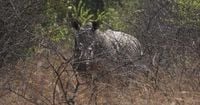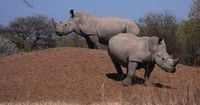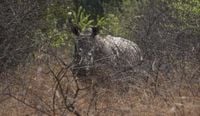On September 22, 2025, conservationists, rangers, and wildlife advocates across South Africa paused to mark World Rhino Day—a day that, for many, is tinged with both pride and frustration. While South Africa boasts the world’s largest populations of black and southern white rhinos, the country remains locked in a relentless struggle against poaching, losing nearly one rhino every day to the illegal horn trade.
The Dinokeng Game Reserve, a sprawling sanctuary just outside Pretoria, stands as a testament to both the progress and the challenges in this ongoing battle. The reserve’s rhino population is thriving, but details about their exact numbers and the security protocols in place are kept strictly confidential. According to The Associated Press, this secrecy is necessary to prevent poachers from exploiting any vulnerabilities. “It would be naive to think that poaching is not a threat even though we haven’t had incidents in many years,” said Marius Fuls, a wildlife monitor and ranger at Dinokeng. “Poaching is always a threat.”
South Africa’s role as a global custodian for rhinos is both a point of pride and a heavy burden. The country is home to more than 2,000 of the world’s 6,700 remaining black rhinos and between 12,000 and 13,000 of the 15,000 southern white rhinos left on Earth, according to figures reported by The Washington Times and Devdiscourse. These numbers represent a remarkable recovery for the southern white rhino, which was on the brink of extinction just a few decades ago. Operation Rhino, a bold translocation effort in the 1960s, is credited with pulling the species back from the edge. But the high concentration of rhinos in South Africa also makes the country a prime target for international crime syndicates that traffic in rhino horn, which can fetch prices higher than gold in illegal markets, particularly in parts of Asia.
Despite decades of conservation work, the threat remains acute. Poaching levels, while down from their peak, are still alarmingly high. According to the South African Environment Ministry, the number of rhinos killed annually by poachers has dropped from well over 1,000 a decade ago to 420 last year. Yet, in just the first half of 2025, 195 rhinos were killed—a grim reminder that the fight is far from over. As AP News noted, that’s still an average of one rhino lost every single day.
On the front lines, rangers like Fuls face daily dangers and emotional strain. He made an impassioned plea for public understanding and support: “Please do not tell a ranger that we’re not going to win this war. If we as conservationists stop believing that we’re going to win this, then we have lost it. We’re the last thin green line between the extinction of rhinos,” Fuls told AP News.
To stay ahead of poachers, South African reserves have embraced high-tech solutions. Anti-poaching teams now deploy drones, night-vision surveillance, radar technology, motion-sensing cameras, and artificial intelligence to monitor both the animals and the vast landscapes they roam. Rhinos at Dinokeng are fitted with electronic tracking devices, allowing rangers to know their whereabouts at all times. K-9 units, trained to detect both intruders and hidden weapons, patrol alongside human teams. Some reserves have even resorted to dehorning rhinos, removing the very feature that makes them a target, in hopes of deterring would-be poachers.
But perhaps the most innovative tactic yet emerged this year: a program to inject small amounts of radioactive material into rhino horns. As reported by AP News, the radioactive markers are harmless to the animals but could make horns unsellable and easily detectable if trafficked across borders. The project, a collaboration between South African scientists and the International Atomic Energy Agency, is still in its early stages, but conservationists hope it will tip the scales in their favor.
Relocation—once a desperate measure, now a carefully coordinated strategy—remains a key pillar of rhino conservation. Following in the footsteps of the original Operation Rhino, organizations like the Peace Parks Foundation have moved nearly 50 black and white rhinos to Zinave National Park in neighboring Mozambique, a reserve that had been decimated by poaching. Gillian Rhodes, combating wildlife crime program manager at Peace Parks, called the operation “an incredible success story,” noting that eight rhino calves have been born in Zinave since the relocation. However, Rhodes cautioned that poaching remains “devastating,” and the costs—both financial and human—are enormous.
The battle for rhino survival is not limited to southern Africa. In Uganda, where rhinos were hunted to extinction in the 1980s, a reintroduction program launched in 1996 has slowly borne fruit. On World Rhino Day, Uganda held its first-ever ceremony to name 17 rhino calves at a sanctuary, a symbolic gesture of hope and resilience. “It’s a powerful statement that Uganda has chosen restoration over despair and resilience over loss,” said James Musinguzi, executive director of the Uganda Wildlife Authority, as quoted in AP News. Uganda now has about 50 rhinos—a small but significant population.
Globally, the picture is even more sobering. According to the International Rhino Foundation, there are about 26,700 rhinos left in the wild. Of the five rhino species, three are found in Asia, and their situation is dire. The greater one-horned rhino numbers just over 4,000, while the Javan and Sumatran rhinos are teetering on the brink of extinction, with only around 50 individuals of each remaining. World Rhino Day, established in 2010, serves as a rallying cry to raise awareness about the threats of poaching and habitat loss facing all rhino species.
South Africa’s conservationists remain cautiously optimistic. They stress that their country’s status as the world’s rhino stronghold comes with immense responsibility. As Gillian Rhodes told AP News, “South Africa has been notoriously really good at conservation … and as a result we still have some of the biggest rhino populations in the world, both white and black rhinos. But because of that success, we have really been the target of rhino poaching and organized crime.”
Looking ahead, experts agree that the fight to save rhinos will require not only advanced technology and international cooperation but also deep engagement with local communities. The hope is that, by working together and refusing to give in to despair, the world can ensure that rhinos remain a living symbol of Africa’s wild heritage for generations to come.



